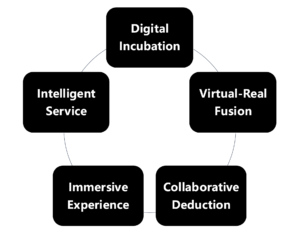Digital Deduction Theatre: An Experimental Methodological Framework for the Digital Intelligence Revitalisation of Cultural Heritage
Digital Deduction Theatre: An Experimental Methodological Framework for the Digital Intelligence Revitalisation of Cultural Heritage
Xiaoguang Wang, Ke Zhao
In the age of digital intelligence, the digitisation and revitalisation of cultural heritage is reflected in the implementation of technology and profoundly affects the way in which science and technology are merged with culture. The digital humanities (DH) laboratory is a multifunctional space that combines digital cultural heritage resources, tools, and interdisciplinary research methods (Pawlicka-Deger, 2020). It encourages collaboration, innovation, and public engagement, and promotes digital preservation, interdisciplinary research, and the wide dissemination of cultural heritage. However, DH lacks design theory and practice to some extent, with an emphasis on graphical presentation and publishing interfaces (Liu, 2013), and has not yet reached the point of being used as a method for knowledge discovery and generation (Burdick et al., 2012, p. 14). There is an urgent need to seek new interactive and participatory design methods for the digital intelligence revitalisation of cultural heritage.
—the Digital Deduction Theatre (DTT) allows the fusion of cultural heritage with digital intelligence environments, providing a new experimental space for humanities research—
Driven by digital intelligence and DH concepts, the Intelligent Computing Laboratory for Cultural Heritage (Philosophy and Social Science Laboratory of the Ministry of Education) at Wuhan University, China constructed the Digital Deduction Theatre (DTT) to provide a feasible path. The laboratory’s theatre is a renewal concept that allows the fusion of cultural heritage with digital intelligence environments, providing a new experimental space for humanities research. Such a theatre can be seen as a situated practice that involves the physicality, virtuality, and design of space; the application of tools and resources; research collaboration; and the spatial representation of practice (Oiva, 2020). Within this new perspective, the integration of theatre with digital intelligence continues to advance, contributing to the creation of theatre-based experimental spaces that integrate people, objects, and technology. The DDT is a cutting-edge interdisciplinary experimental space that explores a new paradigm of experimentation in the humanities. Based on tools and equipment like 3D immersive projection, interactive screens, XR storytelling, advanced modelling, etc., it combines techniques and methods from a variety of fields, including history, information management, humanities, literature, art, and AI. The DDT establishes a complete innovation chain of “Digital Incubation – Virtual-Real Fusion – collaborative deduction-immersive experience – Intelligent Service” (see Figure 1). This chain supports the research and practice of cultural heritage to revitalise the historical, cultural, scientific, and artistic knowledge embodied within it.

Figure 1. The innovative chain for Cultural Heritage Digital Deduction Theatre.
Core Concept and Forms
- Digital Incubation. DDT uses digital devices and high-performance computing to record and archive cultural heritage sites. The purpose is to build open-access knowledge graphs, text databases, image databases, 3D model libraries, cultural gene libraries, GIS platforms, and other cultural heritage smart data. Digital resources provide powerful data support for the preservation, inheritance, and innovation of cultural heritage sites.
- Virtual-Real Fusion. By employing digital twins, GIS technology, and XR devices, DDT aims to establish precise connections, mappings, and overlays between cultural heritage artefacts and their interpretive information and knowledge. This enables seamless integration of the physical world with the digital space.
- Collaborative Deduction. DDT uses methods such as human-intelligence collaboration, open crowdsourcing, data mining, simulated reasoning, and artistic imagination to perform deductive processing of cultural heritage towards the restoration and reproduce historical and cultural scenes. Through collaborative deduction, experts and participants from different fields can collaborate to conduct interdisciplinary research and teaching, thereby offering a comprehensive understanding and representation of cultural heritage from multiple perspectives.
- Immersive Experience. Using XR devices and interactive systems, DDT aims to offer users a simulated reality an interactive three-dimensional visual narrative environment. Users can enter virtual scenes of cultural heritage as digital avatars and interact with characters and their surroundings to experience a sense of presence.
- Intelligent Service. With AIGC technology and large language models such as ChatGPT, DDT aims to provide content generation, intelligent conversation, information retrieval, publication, and dissemination services related to cultural heritage. Through these intelligent services, DDT can support the revitalisation, regeneration, and sustainable inheritance of outstanding Chinese traditional culture, meet users’ knowledge demands, and offer personalised, interactive, and engagement experiences.
Technology Infrastructure
The DDT of cultural heritage takes data as the basis, models as the engine, and technology as the support to analyse, express, and represent cultural heritage in an all-round and multi-dimensional way. A modular technology architecture with adaptability and flexibility was built to guarantee the digital revitalisation of cultural heritage.
- Data Analysis and Management. Using statistical analysis, social network analysis, machine learning, and other professional knowledge, cultural heritage data can be processed and analysed to build various databases that provide data resources for the digital revitalisation of cultural heritage.
- Model Development and Application. Based on the results of the data analysis and management, various algorithms and techniques have been applied to data mining, model construction, and optimisation, including knowledge graph models, digital-real symbiosis models, interpreter collaboration models, digital storytelling models, and large language models, to support the interpretation and presentation of cultural heritage.
- Hardware and Software Support. Enhances the adaptability and flexibility of the theatre, including intelligent voice dialogue platforms, multiscreen systems, project management systems, and visualisation software.
- Situation Simulation and Narrative Development. Allows users to explore and understand different types of cultural heritage deduction forms through role-playing or narrative involvement, deepening their understanding of cultural heritage and empowering them to become more effective knowledge creators.
- Interactive Exhibition and Experience. Provides users with diversified interactive displays and experience methods, including AR, VR, XR, and interactive installations, to better present the history, culture, and value of cultural heritage
- Research and Design. Designing interactions based on user needs in a user-friendly manner enables professionals and non-specialists to engage in research, data exploration, computational modelling, and immersive experiences that promote cultural heritage research and education.
- Sustainable Development. Management. Establish a solid management system, including personnel training, technical support, and quality control, to safeguard the sustainable development of DDT of cultural heritage.
Full paper: Wang, X., Zhao, K., Zhang, Q., & Liu, C. (2024). Digital deduction theatre: An experimental methodological framework for the digital intelligence revitalisation of cultural heritage. In Intelligent Computing for Cultural Heritage(pp. 203-220). Routledge. https://doi.org/10.1145/3706598.3714303.
References
Burdick, A., Drucker, J., Lunenfeld, P., Presner, T., & Schnapp, J. (2012). Digital_Humanities. Mit Press.
Liu, A. (2013). Meaning of digital humanities. pmla, 128(2), 409-423. https://doi.org/10.1632/pmla.2013.128.2.409
Oiva, M. and Pawlicka-Deger, U. (2020). Lab and Slack. Introduction of situated research practices in the digital humanities to the DHQ special issue. DHQ: Digital Humanities Quarterly, 14(3). http://digitalhumanities.org:8081/dhq/vol/14/3/000485/000485.html
Pawlicka-Deger, U. (2020). Laboratory Turn: Exploring Discourses, Landscapes, and Models of the Humanities Laboratory. DHQ: Digital Humanities Quarterly, 14(3). http://www.digitalhumanities.org/dhq/vol/14/3/000466/000466.html
Cite this article in APA as: Wang, X., & Zhao, K. Digital deduction theatre: An experimental methodological framework for the digital intelligence revitalisation of cultural heritage. (2025, May 12). https://informationmatters.org/2025/05/digital-deduction-theatre-an-experimental-methodological-framework-for-the-digital-intelligence-revitalisation-of-cultural-heritage/
Authors
-
-

Ke Zhao, an intuitive interdisciplinary researcher with a diverse academic background, focuses on Digital Humanities, Human-Computer Interaction, and Intercultural Communication, adept at generating innovative research ideas and leading cross-disciplinary projects with a passion for impactful research. She earned her MSc in Digital Humanities from University College London (UK), BFA in Film Studies, and BEng in Digital Production from China and Korea, and is pursuing a PhD at Wuhan University (China).
View all posts





